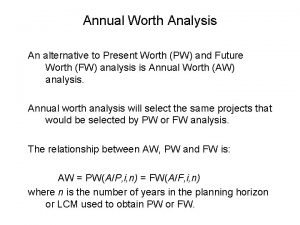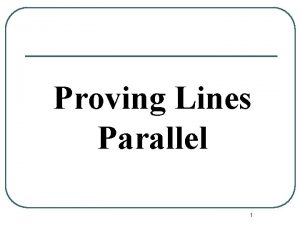Walk the Walk Proving the worth the Community























- Slides: 23

Walk the Walk: Proving the worth the Community Mental Health System Brian Wheelan EVP, Chief Strategy Officer March 30, 2017

About Beacon Health Options § Headquartered in Boston; more than 70 locations in the US and UK § Programs serving Medicaid recipients in 27 states and the District of Columbia § 5, 000 employees nationally and in the UK serving 50 million people § Serving 8. 5 million military personnel, federal civilians and their families § Partnerships with 100 health plans § 2. 5 million lives in NJ through a partnership with Horizon BCBS § 200+ employer clients, including 45 Fortune 500 companies 2

Was the Failed ACA Repeal Good or Bad for BH? Unequivocally Good § Cross-subsidy and money infusion resulting from the adult expansion persists § Particularly helpful to expand improve substance use treatment capacity • Unclear NJ is investing in the right kind of capacity Watch § ACA and Medicaid expansion are ticking time bombs • 90%+ Federal funding, debt financed • New coverage is bad value • Participation rates are insufficient § State flexibility is good for BH • IMD exclusion § Time. NJ BH System is not ready for a big system realignment right now • Explicit braiding of indigent, grants and Medicaid 3

The Challenge for New Jersey’s BH System Behavioral Health System § NJ has been slow to launch system contemporization Physical Health System § Provider consolidation is well underway • Hospitals and physician groups § FFS conversion is a full-time, multi-year endeavor. Managed Care will follow • A lot at risk • FL: -10%; KY: -33%; MA -15%; MD -15%; NH -12%; NY -6% § Pace-car state with respect to payment reform innovation • Medicare, Commercial, PCMH § Financially strong, politically powerful § Providers are fragmented 4

Early AQC results have not been compelling from a behavioral health integration perspective Study compared three cohorts from BCBSMA’s Alternative Quality Contract (AQC) program: AQC w/ BH risk, AQC w/o BH risk and non-AQC FINDINGS INDICATE SIMPLY SHIFTING § Slightly reduced probability of utilization but MH spend same § Less improvement for members with some chronic conditions - in AQC contract that had BH risk than in non-AQC contracts § Initially, insufficient focus on BH Interviews suggested that AQC did not change mental health care delivery in the program’s first years. § Results do not stop the “simplistic integration” arguments Source: Colleen L. Barry, Elizabeth A. Stuart, Julie M. Donahue, Shelly F. Greenfield Elena Kouri, , Kenneth Duckworth, Zirui Song, Robert E. Mechanic, Michael E. Chernew and Haiden A. Huskamp “The Early Impact Of The 'Alternative Quality Contract' On Mental Health Service Use And Spending In Massachusetts. ” Health Affairs, 34, no. 12 (2015): 2077 -2085 5

The emphasis on VBPs is unlikely to ebb any time soon § RFPs and ensuing contracts include commitments to VBPs strategies, including numeric targets (even if they are not well thought out) • NY – glide path to having 85% of payments through VBP structures • MA is ending its managed care program to move to ACOs • Oregon, Colorado, Alabama are all Medicaid programs organized around provider-led structures § Those providers with real VBP experience actually like them • Cash flow, predictability, flexibility, clinical innovation, etc. § For BH specifically, lack of evidence notwithstanding, providers and payers both believe that more good than harm is occurring § Washington remains a wildcard, but I would bet on continued growth of VBPs 6

Beacon is paying hundreds of millions of dollars in BH provider alternative payments today Beacon has implemented ambitious value-based payment programs in Colorado, Texas, Florida, California, and more Colorado: Provider Partner Sub Cap California: Case Management Bundle Illinois: Complex mental illness case rate New Hampshire: Sub-cap for complex mental illness Florida: Provider Sub-cap Texas: Outpatient Case Rates 7

Key learnings and Strategic Implications § Clinical § Financial § Capabilities / Operations § Threats and Opportunities 8

Take a “problem statement” approach to VBPs STANDARD APPROACH: DECIDE TO INNOVATE AND THEN DETERMINE WHY BETTER APPROACH: DEFINE PROBLEM TO SOLVE, THEN EVALUATE INNOVATION § Many organizations make a determination to follow a specific path for reasons unclear § We believe in a “problem statement” approach to innovation, including value-based payments - Senior leadership may pronounce an edict - Key customer may ask/demand it - Policy environment may encourage it § We can think of this as “innovation for innovation’s sake, ” where we may learn something amazing…or not § Hard to determine if the innovation made an impact as you are searching ex post for what you are looking to impact/change § Spend considerable time to accurately define the outcome we are trying to achieve and to lay out how we will know if we achieve it § Then we break the problem into components and determine where, if anywhere, innovation has a role to play Simple concept, but it requires diligence to keep out the noise and focus on the problems and the desired results 9

VBPs are a spectrum of options; we must get the right mix of incentives and complexity to get desired outcomes VALUE-BASED PURCHASING OPTIONS Total Health Outcomes • Shared risk on total member experience Behavioral Health Capitation • Risk for providers • Full behavioral health payment • Defined coverage set COMPLEXITY Episode Bundle • Group of services • Combined payment • Quality goals • Defined time period Case Rate • Group of services • Combined payment • Monthly/weekly payment Pay for Performance (P 4 P) • “Upside only” • Key process measures Fee-for-service • One payment INCENTIVE-BASED TREATMENT RISK Overtreatment Under-treatment 10

What problem are you trying to solve? Be clinically led. Avoid fads. VBPs may be helpful § Length of stay § Readmission rates FFS may be more helpful § New treatment modalities • FEP engagement, CBT for suicide § Community-based medication assisted treatment § Prescribing § SMI Total Cost of Care § Seek and Find “engagement” work § Peer Recovery Specialists § HEDIS Rates ACCESS – scheduling flexibility at scaled centers in dense geographies to create “BH Urgent Care” ACCESS – treatment capacity in genuinely under-served areas 11

Key learnings and Strategic Implications § Clinical § Financial § Capabilities / Operations § Threats and Opportunities 12

More emphasis on “PAYMENT” than “VALUE” § Value is defined as outcomes relative to the real costs § Outcome improvement without understanding the true cost of care is unsustainable and does not help effective allocation of limited resources § Cost reduction / revenue increase without regard to outcomes is not value VALUE = HEALTH OUTCOMES COST § Negotiations are overly focused on the financial envelope (bottom half of the value equation) § VBPs without changing outcomes is a very expensive way to lower cost § Too often in healthcare organizations, the clinical leads are not well coordinated with the contracting leads (both payers and providers) • Leads to an organizational disconnect: Price changed, but things aren’t really going to be that different Proprietary and Confidential 13

Be specific and realistic about “risk” § In real-life negotiations, provider confidence in taking on financial risk is notably low • Data quality, balance sheet, systems, population size, geography, lack of control • May be overly conservative, but conservative is better than the alternative § Helpful distinction between “insurance risk” and “performance risk” • Higher confidence around performance risk on things you know how to do § Be realistic about the trade-offs between risk and administrative flexibility or simplification • A deal predicated mostly on “performance risk” is less likely to yield administrative simplification than a deal predicated on “financial risk” § Sets up a natural partnership opportunity between MBHOs and CMHCs • Beacon takes population/insurance risk and CMHC takes performance risk Proprietary and Confidential 14

Key learnings and Strategic Implications § Clinical § Financial § Capabilities / Operations § Threats and Opportunities 15

The amount of required change is consequential – for both payers and providers It’s complicated; there a lot of systemic and practice level changes that need to happen § Requirements around timely patient access, outcome accountability, process measures, etc. , may be tied to financial payments § Financial reconciliation function is big: thresholds, leakage, maintenance of effort § Cash management becomes critical: VBPs cut both ways on receivables § Utilization management moves from payer-led to provider-led, forcing a re-think of how the provider organizes clinical practice to stay within financial allowances § IT and reporting infrastructure is different: providers need to generate and monitor patient utilization reports and financial utilization reports in a way they have likely not done § Payer / Provider interaction goes up, not down – quality reviews, case rounding, complex case management, transitions to/from higher levels of care § In addition to the new requirements, still have to submit claims accurately, even if they are not paid and instead counted as encounters 16

Administrative costs will INCREASE, for both the payer and provider § Bolstered finance functions § Accurate eligibility maintenance. Critical to understand that payers struggle constantly with eligibility. § Encounters, encounters, encounters • States, CMS are not changing the way they build rates and do risk adjustment • Traditional billing and claims infrastructure is still required (timely filing, accurate provider files, accurate coding, accurate diagnosis) § Increased difficulty: “Flexible supports” still need to be converted into procedure codes: activity tracking § Audits increase. Consequence of new emphasis on “controls” and “vendor oversight” § Do not underestimate time frames and investment required for proper implementation • Know your own organization, but also know your payer 17

Key learnings and Strategic Implications § Clinical § Financial § Capabilities / Operations § Threats and Opportunities 18

Small threat example – new competitors Elements of comprehensive OUD care 1 Psychosocial services Pharmacotherapy Community support system Clinical Case Management Drug Screening OP MAT bundle structure • A OP MAT treatment case rate incorporates outcomes metrics and bonus payments to effectively align financial incentives with high-quality treatment - MAT dosing is bundled with therapy and wrap-around supports - Opioid use disorder (OUD) and co-morbid mental health diagnoses are co-managed by single care team - Program is available for Beacon members seeking MAT treatment for opioid use disorder • The case rate structure is based on the phases of treatment for patients in MAT. This creates a dynamic continuum of patient progress toward intended treatment outcomes: - Intake phase, including assessment, MAT induction, treatment planning and stabilization - 3 maintenance phases with decreasing service levels through which the member progresses by achieving recovery plan goals • Quality metrics will be used to award P 4 P incentives based on successful care outcomes: - Metrics include IP readmissions rate, MAT adherence, and patient quality of life assessment 1 SAMHSA/CSAT Treatment Improvement Protocol: Medication-Assisted Treatment for Opioid Addiction 19

Big Threat Example § For now, the Medicaid expansion stays. Reduced role of indigent care is a threat to the BH safety net § Emphasis on ACOs shifts power to the Medical-Surgical community • Follow the money § “Leaders” in the ACO dialogue are not well-versed in mental health or addiction • Dismissive of the role that BH-specialty plays § Simplistic narrative around integration a very real threat § Massachusetts Community Partner example • Legislative support for CMHCs has been weakened by “Medicaid” and low indigent care • Critical infrastructure role is being dismissed by large health systems • CMHCs may not have the stamina to endure a major policy mistake § Higher risk in NJ because of the FFS conversion distraction and MCO maturity in physical health 20

Example of SMI rate differential by Medicaid category

The Holy Grail: CMHCs at the SMI ACO Core Management Team PCPs Tethered to BH OP to reinforce collaborative care model. SUD OP SUD DIV BH OP (Care Manager) Nurse Practitioner May be BH OP or SUD OP provider depending on primary diagnosis. Embedded NP addresses routine PH care. Crisis Rx MBHO Inclusion in Core Team is region dependent Supports Care Coordinator – including admin, facilitating data exchange, case manager training, etc. BH IP Medical OP Social Service Agencies State Agencies 22

Negotiate A Key Role; Rise to the Occasion § Do not let the FFS challenge distract from the next challenge – Managed Care. Work starts now § Be really clear about a few specific BH problems that are currently unaddressed. • Primary Care for SMI; Access to care with a clear definition; Crisis stabilization and response § Pick things that exemplify the value of a strong, defined community mental health system that is based on recovery principles. Define a role for the MH safety net § Clearly identify and quantify the total cost of care for the SMI § Create a “Maintenance of Effort” framework with re-investment requirements § Create structures to bring scale and operating leverage where there is none today § Don’t get divided. Your unified voice is much more powerful than your individual deal skills 23
 Anything worth doing is not necessarily worth doing well
Anything worth doing is not necessarily worth doing well Annual worth analysis example
Annual worth analysis example Annual worth example
Annual worth example Worth the walk
Worth the walk Fort worth community garden
Fort worth community garden Prepare to scale up in social mobilization
Prepare to scale up in social mobilization Lesson 2-8 proving angle relationships
Lesson 2-8 proving angle relationships Proving statements about segments and angles
Proving statements about segments and angles Proving the ledger
Proving the ledger Unit 2 logic and proof homework 3 conditional statements
Unit 2 logic and proof homework 3 conditional statements Asa postulate
Asa postulate Unit 3 lesson 3 proving triangles similar
Unit 3 lesson 3 proving triangles similar Lesson 3-5 proving lines parallel
Lesson 3-5 proving lines parallel Practice 7-3 proving triangles similar
Practice 7-3 proving triangles similar Wxyz is a rectangle
Wxyz is a rectangle Sas similar triangles
Sas similar triangles Lesson 2-8 proving angle relationships
Lesson 2-8 proving angle relationships 3-3 proving lines parallel
3-3 proving lines parallel Military apartments aberdeen md
Military apartments aberdeen md Geometry proving lines parallel
Geometry proving lines parallel Right triangle congruence theorems
Right triangle congruence theorems 3-3 proving lines parallel
3-3 proving lines parallel 3-3 proving lines parallel
3-3 proving lines parallel Proving inverse functions using composition
Proving inverse functions using composition











































